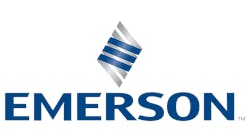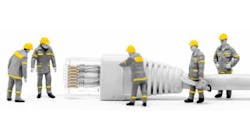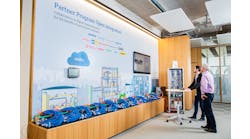By Rich Merritt
Maybe one answer is blowin’ in the wind. North American chemical process plants tend to be wide open, outdoor facilities that enjoy a relatively constant wind, and European facilities tend to be inside buildings. With a higher air speed, explosive dust and vapors can disperse, making the site safer and limiting the number of hazardous areas where safe systems are needed. In Europe, because the buildings are sealed, the entire building is a hazardous area, thus requiring intrinsically safe equipment throughout.
That’s as good a reason as any to explain why Europeans have adopted intrinsically safe I/O and North American plants cling to the age-old practice of putting I/O in purged or explosion-proof cabinets. There are other reasons as well.
In 2003, VDC Research did a study of user preferences in hazardous environments, and explosion-proof and purged cabinets came in first and second, with intrinsic safety coming in fourth. The survey was for users in North America and Europe, and VDC reported that Europeans picked intrinsic safety first, while North America picked explosion-proof cabinets first.
One of the study’s key finding was, “Based on the survey data, it appears much more likely that users will switch to intrinsic safety in the construction of new facilities and in major updating projects in existing facilities, rather than for replacements and minor projects, where the perceived benefits of switching are less.”
However, things may be changing. A recent market study by ARC Advisory Group says that increased emphasis on process safety will cause a 12% growth in safety systems. “The safety system market has experienced unprecedented growth for the last two years,” according to Asish Ghosh, author of the study.
Explosion-Proof Cabinets vs Intrinsic Safety
Essentially, there are two basic ways to keep I/O from sparking and causing an explosion in a hazardous area: The first is to put all the I/O in a purged or explosion-proof cabinet, so any sparks that result inside the cabinet cannot cause an explosion outside the cabinet.
The second method is to use barriers to limit the amount of current going to instrumentation in a hazardous area, so that it can’t cause a spark if a cable is cut or a connection comes loose (Figure 1). This second method is called intrinsic safety.
Figure 1. An intrinsic safety system uses Zener diode safety barriers to limit the amount of current to instrumentation in a hazardous area.
Source: Omega Engineering
Explosion-proof enclosures can be put anywhere in a plant, including in the middle of hazardous areas. However, there is a major drawback—servicing anything inside or outside the cabinet requires shutting off all electrical power before opening the door. This can also shut down an entire process unit.
Explosion-proof cabinets are marvels of engineering, with shaped doors and seals that prevent heat or sparks from an internal explosion from getting outside. Unfortunately, such cabinets often have several interlocks and many bolts holding the seals closed. So, maintenance people may forget—or skip the process in a time crunch—to seal the cabinet properly, thus rendering it unsafe.
Intrinsically safe systems have other advantages. Joseph Kaulfersch, market analyst with Pepperl+Fuchs explains, “When one is making $20,000 an hour on a product, and an instrument can be fixed ‘hot’ or while running, it doesn’t pay to stop production. In the case of explosion-proof, users need to get a hot permit which takes time, plus the process needs to be shut down. An intrinsically safe barrier has a 30-sec return on investment.”
Figure 2. An intrinsically safe installation using Turck IM intrinsically safe barriers.
Source: Turck.
Intrinsically safe I/O, such as I/O cards, fieldbus interfaces and other devices, are kept in a non-hazardous area, with Zener safety barriers or isolation transformers limiting power to instrumentation cables going into hazardous areas (Figure 2). This method eliminates the need for explosion-proof cabinets and makes instrumentation in the hazardous area easier to service, because disconnecting wires to service instruments can’t cause a spark.
However, since IS limits the amount of current going into a hazardous area, you have to use IS instrumentation, switches, monitors and analyzers that can operate on the limited amount of current available. Fortunately, IS-rated instrumentation is becoming more widely available every day.
So How Are IS Sales in North America?
The answer depends on whom you speak to. “I really haven’t seen many requirements for intrinsic safety in North America,” says Bruce Jensen, manager, systems marketing and sales support at Yokogawa. “Those requirements and installations we do have in North America are generally in the pharmaceutical industry, where there is a combination of general-purpose, Class 1 Div II and Class 1 Div 1 areas. Here we have used barriers from different suppliers. Yokogawa does make I/O modules for its I/O subsystem in the Centum series with built-in barriers. However, the market for those appears to be mainly the Middle East and Europe.”
Joseph MacInerney, principal control systems engineer at Fluor, a systems integrator, says, “The trend in North America is still very much against intrinsic safety. The old ideas are too entrenched, plus most plants are existing, so there is a reluctance to change. We are using more and more in the Far East, where I work. Once one is used to the criteria there is no problem. However, it’s difficult to get all IS instruments, so one ends up with a combination of IS and ex-proof.”
Andre Dicaire, product manager at Emerson Process Management, says his company sees a small percentage of its control system I/O channels in North America that require IS protection. “We do a lot of upgrades and expansions in North America, and typically we just connect to the existing field instrumentation,” he says. “Customers do not rip out their functioning field instrumentation to reinstall it using IS barriers.”
On the other hand, P+F’s Kaulfersch says, “It would be inaccurate to say that intrinsic safety it is not popular in the U.S. That was true 15 years ago, but P+F’s intrinsic safety business has been growing organically—without any acquisitions—by 25% per year for the last five years, and a few of our major competitors have also experienced significant growth. In fact, several industry segments have standardized on intrinsic safety for all of their plants in the U.S., as well as around the world.”
Sonja Anderson, application engineer at MTL Instruments, concurs. “Historically, IS has been considered a ‘European’ technology. Yet in the last two years, MTL doubled its sales in the Americas, with a large portion of those sales in IS products. Has intrinsic safety become an American solution? I certainly think so.”
John Riess, regional product manager for distributed I/O at Rockwell Automation, also says IS is growing. “Manufacturers around the world use intrinsic safety measures, including here in the U.S. Also, Latin America is among the fastest-growing markets using intrinsic safety. What we’re seeing is a lot of different industries have hazardous environments that have to be dealt with, and plants are taking measures to ameliorate any potential problems. These measures include using a physical barrier, purged enclosures and products designed to limit the available energy. Some plants use a mix of all three.”
Greenfield Issues
“Our input from customers is that IS wiring methods are indeed increasing in North America,” says Scott Saunders, vice president of sales and marketing at Moore Industries. “However, the adoption rate is certainly slower than the overall growth rate of our industry. The reason for this is the lack of new greenfield plants being built in North America.”
One reason IS makes sense for new plants, Saunders says, is because it’s less expensive. “We see the growth for intrinsic safety is with new chemical, pharmaceutical and petrochemical plants for a couple of reasons,” he explains. “First, many contractors put their projects out for bid throughout the entire international engineering community. If firms that win these contracts reside outside North America, their tendency has been to use intrinsic safety wiring methods due to their experience with it. Second, many of these firms bid on turnkey fixed-bid projects, and have done a financial analysis that determined that intrinsic safety wiring methods for hazardous areas and zones will actually save overall wiring and installation dollars.”
Jim Peterson, product manager at Turck, agrees and says IS is easy to install. “IS installations allow the same wiring techniques used in non-hazardous industrial installations,” he explains. “This eliminates the need to use rigid conduit, armored cable or specially certified cable in these areas. The NEC allows the same cable types used in ordinary industrial installations, including multicore cable that can support multiple IS signals in the same cable.
“The use of IS installation techniques not only simplifies the overall installation, but it also makes installation in hazardous areas a non-issue with maintenance personnel. Electricians with no hazardous-area experience can use the installation methods they are familiar with in any installation that incorporates intrinsic safety. None of the expertise in special wiring techniques that is required with explosion-proof installations is necessary. The use of quick-disconnect technology may be incorporated and used safely in areas that have even the highest potential for the possibility of an explosion without concern.”
The Wireless Factor
As for adding instrumentation in an existing plant, many companies are going to wireless transmitters. An intrinsically safe, battery-powered transmitter completely eliminates the need for barriers, wiring, explosion-proof cabinets, purging and other safety measures.
Kaulfersch disagrees. “Industry is still trying to cut its costs, so wireless technology is being installed. Wireless still needs to be powered in some way, so intrinsic safety is required.”
Dicaire points out that, “Many companies use fiber-optic transmission in hazardous areas, but even fiber optics have to be IS. If a fiber-optic cable is severed, the laser beam can ignite dust particles. Therefore, Emerson developed an IS fiber-optic repeater.”
MTL’s Ian Verhappen points out that the Fieldbus Foundation has adopted IS, too. “Foundation fieldbus makes extensive use of IS, FISCO and FNICO. FISCO and FNICO are not strictly speaking IS technologies, but they allow ‘live working’—that is, the ability to work on the device without requiring a continuous gas test. Live working is critical to fieldbus installations, because to work on a device, you must be able to communicate with it. Unlike conventional analog systems that only require a DC current, fieldbus systems also require system communications, so they can be addressed and modified. But fieldbus devices don’t need to be connected or disconnected often, so much of the work can be done from the maintenance console over the network.”
Do We Need IS?
Dicaire of Emerson says one reason for the low demand for IS in North America is because plants are being built safer these days to meet regulatory targets. “Improved valve packing and seals on field equipment have minimized fugitive emissions, allowing companies to significantly reduce or even eliminate the areas needing Zone 1 classification,” he explains. “So even in new installations where IS can be introduced, the percentage of I/O signals that require it is small.”
At least two observers have questioned the need for intrinsic safety, including our own columnist, John Rezabek, and Mike O’Neill, director at MooreHawke.
Rezabek says in his March 2008 column "Instrinsic Safety Obsolete Yet?," “Why do we install an intrinsically safe instrument system? One reason is the ability to do live work, such as connecting and disconnecting an instrument for calibration or troubleshooting. The other reason is the significant likelihood that the area where an instrument is located routinely has a flammable or explosive mixture of fuel and air present. We’re at a point today where, in many cases, both of these needs are going to or have gone away already.”
O’Neill says, “IS systems were great for analog electronic modules that needed frequent access in the field and for the adjustment of limit switches on valves. Fieldbus devices have no physical adjustments accessible in the field or otherwise, and all changes are made through the segment communications, so putting yourself through the pain of IS fieldbus—and it can be very painful indeed—is not necessary at all! However, company specifications don’t always follow technology very fast.”
Even if it’s true that modern instrumentation and plant design have virtually eliminated problems in hazardous areas, the rules-makers haven’t gotten the message—and it’s the brave corporation that’s willing to eliminate safety systems where they have always been installed. Whether you choose explosion-proof or IS, a legion of local, state, national and international standards organizations, your own company policies and the requirements of your insurance carrier will determine what safety systems you will use.
Rich Merritt is a Control contributing editor.
Playing by the RulesOne problem with both systems is the bewildering array of rules and regulations regarding hazardous areas and classifications. The “zones,” “divisions” and other categories that vary from sytem to system and standard to standard make it hard to tell the players without a detailed scorecard. Gus Elias, standards specialist at Moore Industries, explains the differences between the European ATEX rules and the U.S. and Canadian National Electrical Codes (NEC/CEC): “In the U.S., the classification of hazardous locations is based on the NEC, while in Canada the CEC applies. In Europe, Asia and Australia, the tendency is to follow the recommendations of the International Electrotechnical Commission.” While similar, their definitions of hazardous areas differ:
“It’s important to note that Zone 2 (IEC/Europe) and Division 2 (North America) are similar to a great extent, but are not identical, while Division 1 includes the corresponding Zones 0 and 1,” notes Elias. ( For a quick rundown on the differences see Dan Hebert’s Dec. ’08 Technically Speaking column "Sorting Out ATEX.") Elias says these seemingly minor details have tripped up a number of major control system vendors, who found that their intrinsically safe I/O systems, which met NEC/CEC requirements, did not meet ATEX requirements, and they lost a number of large jobs in Europe as a result. Things may be changing. “U.S. plant installations were historically based on NEC500 [divisions], but in the future, new plants may be designed to NEC505, which encompasses zones and follows IEC standards,” says Elias. “This will allow the worldwide use of similar apparatus and wiring methods, including an increase in the use of intrinsic safety.” |




